
The Salmon [New York state river, USA] has suffered from somewhat
of an identity crisis. Its lower 16 miles receive tremendous run of
trophy-size fish from Lake Ontario. But, it has become as famous
for the hordes that pursue the fish, especially the Chinook [King] salmon,
as it has for the fish itself. [See map, click here.]
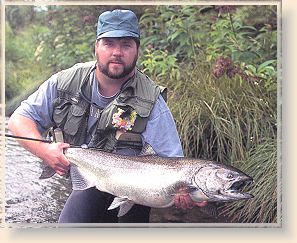
The Salmon means many things to many people. To some it is the
concentrations of big fish. To others it is the camaraderie. Anglers
can be found along the river bank sharing a few stories over a hot
cup of coffee. Some seem to enjoy this as much as the fishing. To
me it is a river of great challenge. It is a puzzle to be solved each day
on the water and the solution is usually not constant. Finding willing
fish and properly presenting the fly is only part of the equation. To
land fish on this river can be a challenge in itself, caused by powerful
fish and the Salmon's River's characteristic heavy flows. But the
rewards are great. It is a river that only rarely allows itself to be
conquered. But this is what beings me back.
In the early 1800s the village of Pulaski was established. Most of the
trees along the river were cut and used in the settlement of the new village.
Settlers were attracted to this vast waterway for a number of reasons.
The most important may have been the fish. Tremendous runs of salmon.
Ironically, not the Chinook salmon that the river has become noted
for in recent years, but Atlantic Salmon. It was the Atlantic salmon
after which the river was named. They were native to Lake Ontario
which was host to such a vast population that it nearly defies
comprehension. . . . One settler's account was spelled out in the
New York Fish and Game Journal, January 1982:
[an account of the year 1836] "Twelve skiffs in one night have taken
an average of three hundred Salmon each."(George Goode, 1884:473).
By 1898, the runs of the Salmon River were also decimated and this
great population was lost forever.
The New York State Department of Environmental Conservation (DEC),
along with the province of Ontario and the Fishland Wildlife service began
experimental stocking [coho and chinook salmon] in Lake Ontario.
They were met with limited success because of another introduced species,
the sea lamprey. Lamprey control began in 1971 and was continued through
federal funding and involvement. Once the control began taking hold, the
stocking proved to be very fruitful. Steelhead were then stocked in the
early 1970s . . . Brown trout were also added to the mix.
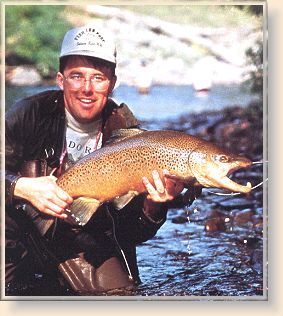 All the introduced species returned to the Salmon river and almost
instantly a river fishery was established. There was even some natural
reproduction in the tributaries to the main river. Reproduction in the
river itself was limited by two hydroelectric dams built in the early 1900s. . .
To the surprise of many, solid reproduction on Salmon River tributaries
such as Orwell Brook and Trout Brook produce a large number of wild
fish. It is estimated that as much as 30 to 40 percent of the annual steelhead
run is comprised of naturally reproduced fish. In addition, 10 to 15 percent
of the Chinook salmon and brown trout returning to the river are wild fish.
All the introduced species returned to the Salmon river and almost
instantly a river fishery was established. There was even some natural
reproduction in the tributaries to the main river. Reproduction in the
river itself was limited by two hydroelectric dams built in the early 1900s. . .
To the surprise of many, solid reproduction on Salmon River tributaries
such as Orwell Brook and Trout Brook produce a large number of wild
fish. It is estimated that as much as 30 to 40 percent of the annual steelhead
run is comprised of naturally reproduced fish. In addition, 10 to 15 percent
of the Chinook salmon and brown trout returning to the river are wild fish.
A River of Seasons
The Northeast portion of the United States is blessed with the beauty
of changing seasons. This is a characteristic that adds to the diversity
of the Salmon River. Each season has it's own attraction and appeal,
giving the river a variety of appearances throughout the year.
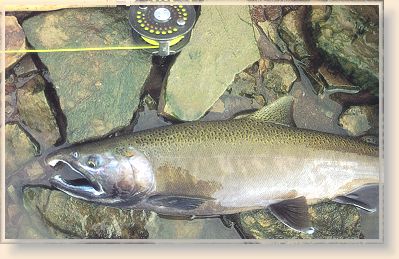
Late summer and early fall is viewed by most as the beginning of the
Salmon River Season. The large runs of migrating trout and salmon,
coupled with comfortable air temperatures, bring many anglers to the
river. In late August and September the river is lined with fertile plant
life and green trees. Most days can be fished in light clothing and
summer weight waders. Weather conditions are typically dry, causing
the flows to adhere to scheduled minimum [water] releases.
In late September and October, the river begins to change its look
almost daily. The hardwoods show a constant progression of color.
Greens give way to brilliant hues of yellow, orange and red. . .in the
middle of October and it is wonderful to be on the river. This time
of year also brings with it the promise of the first major movement
of the true prize to the serious angler, fresh run steelhead.
In November most of the leaves have fallen and the river now seems
naked . . .This is my favorite time to be on the Salmon. Good numbers
of steelhead can normally be found and temperatures can be quite
comfortable.
Winter is a time for solitude on the river. Finding stretches with little
or no fishing pressure becomes easy. Many times you find yourself
alone with a pool of steelhead.
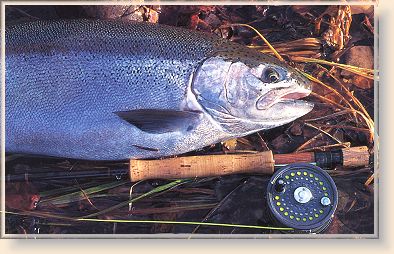
Spring rains and run-off define the expected conditions in March and
April. However, the line between winter and spring is never clearly
defined on the Salmon River. Substantial snow storms can be
experienced into April. Flows will typically be high and strong, and
two units of water [released from the dam] at this time can be expected.
As the melting snow disappears along the river, keeping the water cold,
and refreshing hope that winter conditions will soon be left behind
now prevails.
Trees along the river begin to show life again in May. Warm weather
returns. Late run steelhead as well as post spawn fish provide the quarry.
With raising water temperatures the fish can be quite active. By June and
July everything is green. The best fishing opportunities are found on the
upper river for stream-bread trout. Temperatures can be hot during the
day but are normally cool in the evening providing great weather for
camping near the river.
Fly Fishing the Salmon River
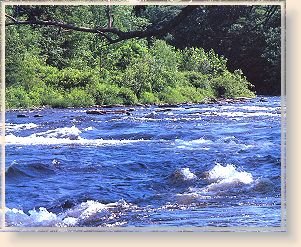 The fly tackle requirements for fishing the lower Salmon River are quite
simple. Seven or eight weight rods are a good match for steelhead and
brown trout, while eight and nine weight rods are the right choice for
Chinook salmon. Some guides prefer five and six weight rods for
steelhead to better accommodate very light tippets. Rod length is
important for proper line control. It should be a minimum of nine feet.
My preference is is a ten foot rod. The main characteristic of the reel
is a smooth, adjustable drag. There should be no hesitation in the drag
when a fish takes line from the spool. This is important to handle the
start and stop fight of a steelhead. The adjustable drag provides flexibility
when using light tippets or for fighting in confined areas.
The fly tackle requirements for fishing the lower Salmon River are quite
simple. Seven or eight weight rods are a good match for steelhead and
brown trout, while eight and nine weight rods are the right choice for
Chinook salmon. Some guides prefer five and six weight rods for
steelhead to better accommodate very light tippets. Rod length is
important for proper line control. It should be a minimum of nine feet.
My preference is is a ten foot rod. The main characteristic of the reel
is a smooth, adjustable drag. There should be no hesitation in the drag
when a fish takes line from the spool. This is important to handle the
start and stop fight of a steelhead. The adjustable drag provides flexibility
when using light tippets or for fighting in confined areas.
A wide variety of flies are used to take
fish on the Salmon River. Such a variety supports my belief that the
presentation of the fly is much more important than the pattern itself.
Therefore, a simple fly selection is normally all that is required for
success on the lower river.
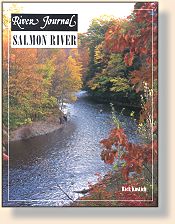
The Salmon River represents a touch of wilderness in close proximity
to so many population centers. It is a river where the quality of the
experience is all in what you make it. The opportunity is there and
with patience and persistence you can come away with memories
that last a lifetime. ~ Rick Kustich
For a map of The Salmon River, click here.
For the flies for The Salmon River, click here.
To ORDER Salmon River direct from the publisher, click
HERE.
Credits: From The Salmon River part of the River
Journal series, published by Frank Amato Publications.
We greatly appreciate use permission.
|



 The fly tackle requirements for fishing the lower Salmon River are quite
simple. Seven or eight weight rods are a good match for steelhead and
brown trout, while eight and nine weight rods are the right choice for
Chinook salmon. Some guides prefer five and six weight rods for
steelhead to better accommodate very light tippets. Rod length is
important for proper line control. It should be a minimum of nine feet.
My preference is is a ten foot rod. The main characteristic of the reel
is a smooth, adjustable drag. There should be no hesitation in the drag
when a fish takes line from the spool. This is important to handle the
start and stop fight of a steelhead. The adjustable drag provides flexibility
when using light tippets or for fighting in confined areas.
The fly tackle requirements for fishing the lower Salmon River are quite
simple. Seven or eight weight rods are a good match for steelhead and
brown trout, while eight and nine weight rods are the right choice for
Chinook salmon. Some guides prefer five and six weight rods for
steelhead to better accommodate very light tippets. Rod length is
important for proper line control. It should be a minimum of nine feet.
My preference is is a ten foot rod. The main characteristic of the reel
is a smooth, adjustable drag. There should be no hesitation in the drag
when a fish takes line from the spool. This is important to handle the
start and stop fight of a steelhead. The adjustable drag provides flexibility
when using light tippets or for fighting in confined areas.
 All the introduced species returned to the Salmon river and almost
instantly a river fishery was established. There was even some natural
reproduction in the tributaries to the main river. Reproduction in the
river itself was limited by two hydroelectric dams built in the early 1900s. . .
To the surprise of many, solid reproduction on Salmon River tributaries
such as Orwell Brook and Trout Brook produce a large number of wild
fish. It is estimated that as much as 30 to 40 percent of the annual steelhead
run is comprised of naturally reproduced fish. In addition, 10 to 15 percent
of the Chinook salmon and brown trout returning to the river are wild fish.
All the introduced species returned to the Salmon river and almost
instantly a river fishery was established. There was even some natural
reproduction in the tributaries to the main river. Reproduction in the
river itself was limited by two hydroelectric dams built in the early 1900s. . .
To the surprise of many, solid reproduction on Salmon River tributaries
such as Orwell Brook and Trout Brook produce a large number of wild
fish. It is estimated that as much as 30 to 40 percent of the annual steelhead
run is comprised of naturally reproduced fish. In addition, 10 to 15 percent
of the Chinook salmon and brown trout returning to the river are wild fish.